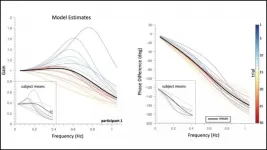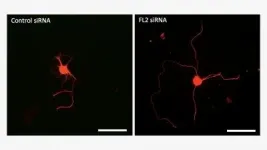(Press-News.org) PHILADELPHIA-- A retrospective study led by researchers from Penn Medicine found that with MitraClip for treatment of secondary mitral regurgitation (MR), a heart disease associated with problems in the left ventricle, there was no negative effect of having a slightly smaller mitral valve opening as long as there was good reduction of the mitral regurgitation. The study is published today in JACC: Cardiovascular Interventions.
"This data is very reassuring for physicians who place MitraClips in patients with secondary mitral regurgitation. It demonstrates that the benefits of MR reduction in patients with heart failure were maintained even when mild-to-moderate mitral stenosis, which can be caused by a narrowing of the mitral valve, occurred after MitraClip," said lead author Howard C. Herrmann, MD, the John Winthrop Bryfogle Professor of Cardiovascular Diseases in the Perelman School of Medicine at the University of Pennsylvania and Health System Director for Interventional Cardiology. Penn co-authors included Rim Halaby, MD, interventional cardiovascular fellow and Suveeksha Naidu, BS, research coordinator.
With secondary MR, the mitral valve itself is usually normal, but other factors cause abnormal function of the left ventricle, which then in turn prevents the mitral valve from closing normally. During the FDA-approved MitraClip procedure, doctors attach a small clip to the mitral valve to help it close more completely, restoring normal blood flow through the heart. If the valve opening gets too small, the valve could obstruct blood flow to the left ventricle, creating an increase in the pressure gradient across the mitral valve. This has the potential to cause mitral stenosis, where the amount of oxygen carrying blood coming from the lungs is reduced, leading to tiredness and shortness of breath. When placing a MitraClip, the valve becomes slightly smaller, which raises the gradient, and researchers previously did not know whether patients would lose the benefit of the treatment if that gradient got too high.
The COAPT Trial was the first randomized trial that showed MitraClip was a safe treatment for many patients with secondary MR with improved outcomes, including a close to 40% reduction in death at 2 years and 50% reduction in heart failure hospitalizations. In 2019, the FDA approved MitraClip for secondary MR in patients who are too high-risk for surgery, and it changed the way physicians approached heart failure and mitral regurgitation. In this latest study, researchers went back and looked at patients from the COAPT Trial and compared those who had high gradients to those who had low gradients.
This study finds that even the patients with high gradients - those which would have previously been considered too high in primary MR - had the same benefit in terms of reduced death and heart failure hospitalization, compared with the patients who had lower gradients. For this set of patients who were approved for the COAPT trial, the benefits of MitraClip with secondary MR reduction outweigh the slight increase in gradient.
"The use of MitraClip to treat secondary MR has meant that physicians have a better way to help more of the population impacted by this kind of heart disease, specifically patients who would not be able to qualify for major surgery," Herrmann said. "It is paramount that we as researchers continue to study outcomes with new devices after they come to market so that patients can receive the greatest benefits of treatment."
The study also found evidence of improvements in some measures of quality of life in patients who had higher gradients, but further study is needed to assess whether the same would be true during exercise or other activities. Since the study was retrospective and not randomized, it does not show it's necessarily safe for physicians to add another MitraClip during a procedure. However, the study suggests that in this specific set of COAPT Trial patients in which physicians made decisions about reducing MR with the addition of multiple clips, the benefits of MR reduction outweighed the detrimental effects of a higher mitral gradient.
INFORMATION:
The COAPT Trial was sponsored by Abbott, which also provided funding to the Cardiovascular Research Foundation to support statistical analysis and administrative/editorial assistance or this study. Herrmann has received institutional grant support and consulting fees from Abbott Vascular.
Penn Medicine is one of the world's leading academic medical centers, dedicated to the related missions of medical education, biomedical research, and excellence in patient care. Penn Medicine consists of the Raymond and Ruth Perelman School of Medicine at the University of Pennsylvania (founded in 1765 as the nation's first medical school) and the University of Pennsylvania Health System, which together form a $8.9 billion enterprise.
The Perelman School of Medicine has been ranked among the top medical schools in the United States for more than 20 years, according to U.S. News & World Report's survey of research-oriented medical schools. The School is consistently among the nation's top recipients of funding from the National Institutes of Health, with $496 million awarded in the 2020 fiscal year.
The University of Pennsylvania Health System's patient care facilities include: the Hospital of the University of Pennsylvania and Penn Presbyterian Medical Center--which are recognized as one of the nation's top "Honor Roll" hospitals by U.S. News & World Report--Chester County Hospital; Lancaster General Health; Penn Medicine Princeton Health; and Pennsylvania Hospital, the nation's first hospital, founded in 1751. Additional facilities and enterprises include Good Shepherd Penn Partners, Penn Medicine at Home, Lancaster Behavioral Health Hospital, and Princeton House Behavioral Health, among others.
Penn Medicine is powered by a talented and dedicated workforce of more than 44,000 people. The organization also has alliances with top community health systems across both Southeastern Pennsylvania and Southern New Jersey, creating more options for patients no matter where they live.
Penn Medicine is committed to improving lives and health through a variety of community-based programs and activities. In fiscal year 2020, Penn Medicine provided more than $563 million to benefit our community.
While cardiovascular disease (CVD) remains the leading cause of death globally, new research led by NYU Grossman School of Medicine and Moi University School of Medicine (Kenya) found that addressing and incorporating social determinants of health (such as poverty and social isolation) in the clinical management of blood pressure in Kenya can improve outcomes for patients with diabetes or hypertension.
The study -- recently published online in The Journal of the American College of Cardiology - found that after one year, patients who received a multi-component intervention that combined community microfinance groups with group medical visits (where patients with similar medical conditions met together with a clinician and community health worker) ...
A first-of-its-kind study led by The University of Texas at Austin has found that rock weathering and water storage appear to follow a similar pattern across undulating landscapes where hills rise and fall for miles.
The findings are important because they suggest that these patterns could improve predictions of wildfire and landslide risk and how droughts will affect the landscape, since weathering and water storage influence how water and nutrients flow throughout landscapes.
"There's a lot of momentum to do this work right now," said study co-author Daniella Rempe, an assistant professor at the UT Jackson School of Geosciences Department of Geological Sciences. "This kind of data, across large scales, is what is needed to inform next-generation models of land-surface processes."
The ...
The fact that the human body is made up of cells is a basic, well-understood concept. Yet amazingly, scientists are still trying to determine the various types of cells that make up our organs and contribute to our health.
A relatively recent technique called single-cell sequencing is enabling researchers to recognize and categorize cell types by characteristics such as which genes they express. But this type of research generates enormous amounts of data, with datasets of hundreds of thousands to millions of cells.
A new algorithm developed by Joshua Welch, Ph.D., of the Department of Computational Medicine and Bioinformatics, Ph.D. candidate Chao Gao and their team uses online learning, greatly speeding up this process and providing a way for researchers ...
A lot about the human brain and its intricacies continue to remain a mystery. With the advancement of neurobiology, the pathogenesis of several neurodegenerative diseases (ND) has been uncovered to a certain extent along with molecular targets around which current therapies revolve. However, while the current treatments offer temporary symptomatic relief and slow down the course of the disease, they do not completely cure the condition and are often accompanied by a myriad of side effects that can impair normal daily functions of the patient.
Light stimulation has been proposed as a promising therapeutic alternative for treating various ND like ...
The brain's auditory system tracks the speed and location of moving sounds in the same way the visual system tracks moving objects. The study recently published in eNeuro lays the groundwork for more detailed research on how humans hear in dynamic environments.
People who use hearing aids have trouble discriminating sounds in busy environments. Understanding if and how the auditory system tracks moving sounds is vital to improving hearing aid technology. Prior research utilizing eye movements to gauge whether the brain is following the trajectory of a moving sound indicates it cannot. A new study from García-Uceda Calvo et al. instead used head movements, a more accurate measure of sound tracking.
The team analyzed head movements of hearing ...
April 19, 2021--(BRONX, NY)--Researchers at Albert Einstein College of Medicine have developed a topical drug that regenerates and restores the function of erectile nerves damaged by radical prostatectomy, the most common treatment for localized prostate cancer. The drug was tested in rats, and the findings were published online today in JCI Insight.
"Erectile dysfunction (ED) after radical prostatectomy has a major impact on the lives of many patients and their partners," said study co-leader David J. Sharp, Ph.D., professor of physiology & biophysics and of ophthalmology and visual sciences and professor in the Dominick P. Purpura Department of Neuroscience at Einstein. "Since rats are reliable animal models in urologic research, our drug offers real hope of normal sexual ...
DALLAS - April 19, 2021 - Treating people with Type 2 diabetes with a new once-a-week injectable insulin therapy proved to be safe and as effective as daily insulin injections, according to the results of two international clinical trials published online today in Diabetes Care. The studies suggest that the once-weekly treatment could provide a convenient alternative to the burden of daily insulin shots for diabetes patients.
Starting and maintaining insulin treatment remain a challenge for millions of patients worldwide with Type 2 diabetes. Fear of injections and the inconvenience and burden of injectable therapy contribute to the barriers against insulin therapy initiation and adherence. The effectiveness and safety of ongoing insulin treatment are also highly dependent ...
Data from a GPS network in Colombia have revealed a shallow and fully locked part on the Caribbean subduction zone in the country that suggests a possible large earthquake and tsunami risk for the northwest region.
The locked patch south of Cartagena city is capable of generating a magnitude 8.0 earthquake every 600 years, said Sindy Lizarazo of Nagoya University in Japan, who presented the study at the Seismological Society of America (SSA)'s 2021 Annual Meeting.
Colombia lies in the middle of a complex tectonic zone, where the Caribbean, Nazca and South American tectonic plates and other smaller tectonic blocks converge. The Caribbean plate ...
Boston College seismologist John Ebel and his colleagues have noted a pattern for some large California earthquakes: magnitude 4 or larger earthquakes occur at a higher rate along a fault in the two decades or more prior to a magnitude 6.7 or larger earthquake on the fault.
The findings prompted Ebel in 2017 to suggest a prospective test. He looked for the California faults that had magnitude 4 or larger earthquakes occurring at a rate higher than 0.5 earthquakes per year from 1997 to 2016. If the pattern holds, the next magnitude 6.7 earthquakes in California are most likely to ...
Eighteen minutes might be all it takes to ensure a full recovery for stroke patients in rural South Carolina.
By changing EMS workflows and incorporating telemedicine techniques, physicians at MUSC Health have partnered with Georgetown Memorial Hospital and Hampton Regional Medical Center to significantly shorten the time between a patient's stroke symptom onset and their treatment, as recently reported in the Journal of Stroke and Cerebrovascular Diseases.
Through MUSC Health's Telestroke Network, emergency medical technicians (EMTs) can video chat with stroke specialists to begin a patient's consult before they even arrive at the hospital. ...




